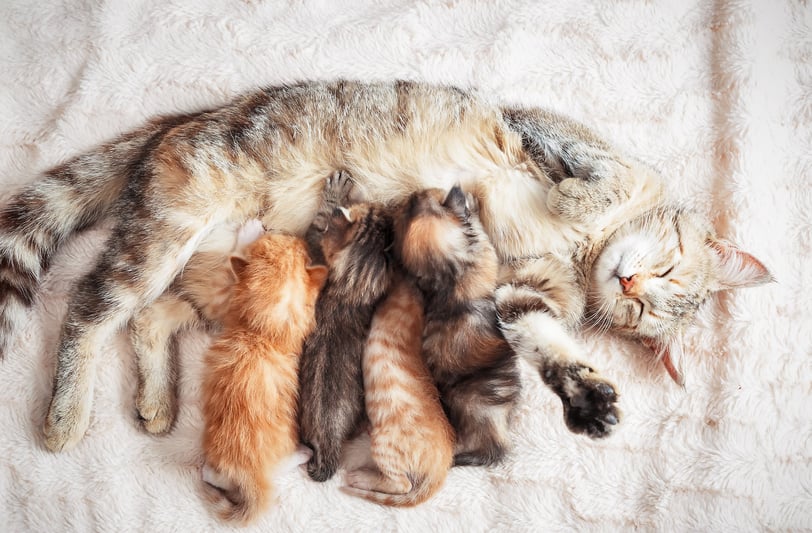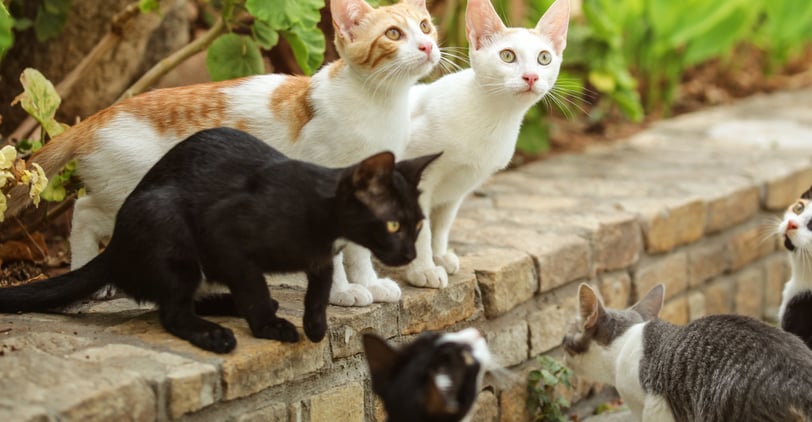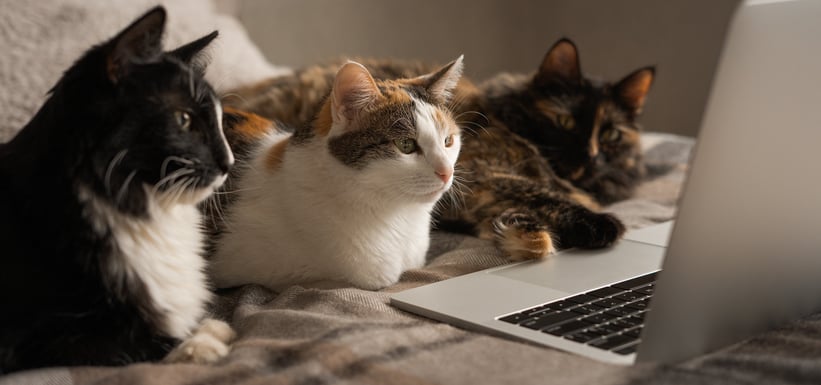Cat Advocacy: How You Can Help
Learn about the problems cats face both inside shelters and in the community, as well as what you can do to support cat advocacy.
12/19/20236 min read
According to the American Association of Feline Practitioners, there are an estimated 70 to 100 million feral cats roaming the streets in the United States. (1) Additionally, an estimated 3.2 million cats enter shelters nationwide every year, according to the American Society for the Prevention of Cruelty to Animals, and sadly, approximately 20% of those cats will be euthanized. (2) While these numbers are decreasing from what they were a decade ago, cats in our communities still face a multitude of problems, and as cat lovers, we must advocate for these voiceless animals.


The Problems Cats Face, Inside and Outside the Shelter
Currently, our streets and shelters nationwide are overrun with cats, and without help from the community through programs such as trap-neuter-return, the cat population will continue to grow rapidly. A female cat can go into heat as early as 6 months of age, and with a gestation period of roughly 2 months, she could have as many as five litters a year. If she is a community cat, better known as a feral cat, those kittens only stand a 75% chance of surviving past 6 months old. Those who do survive often become the parents of yet another generation of cats, and the overpopulation continues.
While shelter cats do face better odds, they still face their own problems. Older or shy cats often struggle to find adopters, and shelters often lack the resources they need to care for so many cats. Sadly, this lack of resources often leads to euthanizing cats due to overcrowding. Oftentimes, these euthanized cats are completely healthy or have an easily treatable illness; there just isn't enough room for them because new cats are coming in every day.
While shelter cats do face better odds, they still face their own problems. Older or shy cats often struggle to find adopters, and shelters often lack the resources they need to care for so many cats. Sadly, this lack of resources often leads to euthanizing cats due to overcrowding. Oftentimes, these euthanized cats are completely healthy or have an easily treatable illness; there just isn't enough room for them because new cats are coming in every day.
© bozhdb /Adobe Stock
Knowing these problems that cats face, I’m sure you are wondering what you can do to help. One way is by caring for the community cats in your area. Many of these cats rely on caregivers for food, water, and shelter, and surveys show only about 10% of the American public feeds outdoor cats that they don’t own (3).
What You Can Do to Support Cat Advocacy


© Lubo Ivanko /Adobe Stock
Providing good-quality food regularly is a great way to help. Make sure you feed in the same place every time, and don't leave food out for more than 30 minutes, as this can attract other animals and insects. You can also deter insects by putting the feeding dishes in a pan with a thin layer of water at the bottom. This will keep insects from crawling into the dishes. It is best to feed dry food only in the winter, as wet food can freeze quickly in cold climates.
Water is also important, especially in the summer. Cats often prefer to drink water a slight distance away from where they eat, so when setting up water dishes, it’s good to keep that in mind. In the winter, you can use wider, deeper water dishes to prevent the water from freezing as quickly. You should also make sure the water is kept fresh and free of any debris.
Cats are quite skilled at finding shelter for themselves, but you can help by providing extra spots for them to sleep and escape the elements. There are many pre-made shelters you can buy, but you can also make your own using a container or a styrofoam cooler. If you choose this route, there are a few things to remember. The shelter should be small so that it preserves heat, and the hole should only be large enough for a cat to enter. In the winter, it is especially important that the bedding used does not absorb moisture, so avoid things like towels or blankets. The best bedding option is hay. Also, be sure the shelter faces away from the wind and is off the ground to prevent it from becoming damp.
Cats are still often seen as a nuisance. This is because unneutered cats, especially males, are prone to spraying and fighting. You can help lessen these unwanted behaviors by contacting a local trap-neuter-return program, or, if there isn't one in your area, start TNR in the community yourself. Alley Cat Allies offers a great step-by-step guide to TNR that you can access here. Community cats also often wander into or relieve themselves in unwanted areas, which can be a nuisance in the community. To prevent this unwanted behavior, you can create litter areas for them using a sandbox, and numerous humane deterrents can be used to keep cats away from areas they aren't wanted in.
Finally, donating time, money, or resources, such as food or litter, to your local humane society or cat advocacy nonprofit organization is always a great way to help advocate for cats. Shelters are always seeking volunteers to help at the shelter or foster pets in their homes. You can contact your local humane society to learn what steps to take to become a volunteer. Shelters are also commonly underfunded and often struggle to afford food and medical attention for all the animals under their care. A donation of food, litter, or money can be a huge help to these organizations. Numerous nonprofit organizations focus on helping cats, and making donations to these organizations is a great way to help support their cause.
Organizations to Give to in Support of Cat Advocacy
Many organizations support cat advocacy, and giving back to them in any way is a great step to take in supporting cats. While several amazing nonprofit organizations exist that benefit cats, I would like to take the time to highlight three today whose mission and work I really love. I suggest you also do your own research to find other great organizations and charities supporting cats that you can support.
Alley Cat Allies is a nonprofit organization seeking to protect and improve cats’ lives. They were founded in 1990 when they began their first community cat colony, and they have championed TNR programs across the globe. They seek to reform public policies by ending outdated laws that harm cats, save cats in shelters by implementing changes in the animal control system to end unneeded euthanasia, and change attitudes towards cats by ending myths and stigmas through education. You can donate to them here.
The Best Friends Animal Society is a nonprofit organization seeking to end pet homelessness. They were founded in 1984 by a group of friends who wanted to make a change in shelters. Currently, the main goal they are seeking is to make the US a no-kill country by 2025. They are achieving this by simplifying adoption policies, providing low-cost spay/neuter, and building foster programs. You can donate here to support them in their efforts to reach that goal.
The Paw Project is a nonprofit organization seeking to educate the public about declawing and put an end to the practice. Declawing is an issue that many people don’t understand and can cause lasting complications for the cat. Their stance is that declawing is mutilation, inhumane, and unnecessary. They also help offer reparative surgeries for declawed cats. You can help support this organization by donating here.


Evgenia Terekhova


Cats today are still greatly misunderstood and face many problems, but with your help and organizations like the ones above, we can work towards a brighter future for cats. These voiceless animals need our support, though. Whether it is through feeding the cats in your own community, lobbying for legal change, or donating resources to your local humane society or nonprofit organization, there is so much you can do to advocate for cats. I hope this article has inspired you to go out and take that first step today.
© Photocreo Bednarek /Adobe Stock
Sources:
(1) “Free-roaming, Abandoned, and Feral Cats Position Statement.” American Association of Feline Practitioners, https://catvets.com/guidelines/position-statements/free-roaming-abandoned-and-feral-cats. Accessed 8 December 2023.
(2) “Pet Statistics | Shelter Intake and Surrender.” ASPCA, https://www.aspca.org/helping-people-pets/shelter-intake-and-surrender/pet-statistics. Accessed 8 December 2023.
(3) Riley, Michelle. “Managing community cats.” HumanePro, https://humanepro.org/page/managing-community-cats. Accessed 15 December 2023.
